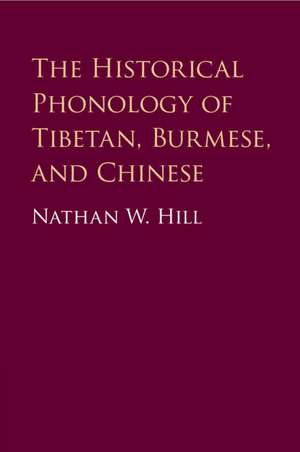The Historical Phonology of Tibetan, Burmese, and Chinese
Autor Nathan W. Hillen Limba Engleză Paperback – 8 iun 2022
| Toate formatele și edițiile | Preț | Express |
|---|---|---|
| Paperback (1) | 235.13 lei 6-8 săpt. | |
| Cambridge University Press – 8 iun 2022 | 235.13 lei 6-8 săpt. | |
| Hardback (1) | 497.92 lei 3-5 săpt. | +35.12 lei 4-10 zile |
| Cambridge University Press – 7 aug 2019 | 497.92 lei 3-5 săpt. | +35.12 lei 4-10 zile |
Preț: 235.13 lei
Nou
Puncte Express: 353
Preț estimativ în valută:
44.99€ • 46.98$ • 37.15£
44.99€ • 46.98$ • 37.15£
Carte tipărită la comandă
Livrare economică 15-29 aprilie
Preluare comenzi: 021 569.72.76
Specificații
ISBN-13: 9781316601518
ISBN-10: 131660151X
Pagini: 387
Dimensiuni: 152 x 228 x 21 mm
Greutate: 0.52 kg
Editura: Cambridge University Press
Colecția Cambridge University Press
Locul publicării:Cambridge, United Kingdom
ISBN-10: 131660151X
Pagini: 387
Dimensiuni: 152 x 228 x 21 mm
Greutate: 0.52 kg
Editura: Cambridge University Press
Colecția Cambridge University Press
Locul publicării:Cambridge, United Kingdom
Cuprins
Introduction; Part I. Tibetan: 1. Old Tibetan; 2. Classical Tibetan; 3. The Bodish languages; 4. Tibetan diachronic phonology: 4.1. From Old Tibetan to proto-Bodish; 4.2. Reprise: from proto-Bodish to Old Tibetan; 4.3. From proto-Bodish to Trans-Himalayan; 4.4. Reprise: from Trans-Himalayan to proto-Bodish; 4.5. Diachronic mysteries; Part II. Burmese: 1. Old Burmese; 2. Written Burmese; 3. The Burmish languages; 4. The Loloish languages; 5. Burmese diachronic phonology: 5.1. From Burmese to proto-Burmish; 5.2. Reprise: proto-Burmish to Old Burmese; 5.3. From proto-Burmish to Trans-Himalayan; 5.4. Reprise: Trans-Himalayan to proto-Burmish; 5.5. Diachronic mysteries; Part III. Chinese: 1. Old Chinese: 1.1. Middle Chinese; 1.2. Rhymes of the Shījīng; 1.3. Structure of Chinese characters; 1.4. Less traditional sources of data for reconstructing Old Chinese; 2. Simplex initials of Old Chinese: 2.1. Internal reconstruction of Middle Chinese initials; 2.2. Expanding the Old Chinese initials using xiéshēng evidence; 3. Old Chinese pre-initials: 3.1. Reconstructing tight pre-initials using xiéshēng evidence; 3.2. Reconstructing tight pre-initials on the basis of morphological speculation; 3.3. Reconstructing tight pre-initials using proto-Mĭn; 3.4. Reconstructing tight pre-initials using loans into Vietic; 3.5. Reconstructing tight pre-initials using loans into Hmong-Mien; 3.6. Reconstructing tight pre-initials using loans into Tai-Kadai; 3.7. Reconstructing loose pre-initials; 3.8. Reconstructing loose pre-initials using proto-Mĭn; 3.9. Reconstructing loose pre-initials using xiéshēng evidence; 3.10. Reconstructing loose using loans into non-Sinitic languages; 3.11. Reconstructing loose pre-initials on the basis of morphological speculation; 4. Old Chinese medial; 5. Old Chinese vowels; 6. Origins of the tones and fnal clusters; 7. Finals of Old Chinese; 8. How to reconstruct a word in Old Chinese; 9. From Old Chinese to Trans-Himalayan; 10. Reprise: Trans-Himalayan to Old Chinese; 11. Diachronic mysteries; Part IV. Trans-Himalayan: 1. Overview of Trans-Himalayan phonology; 2. Initials of Trans-Himalayan: 2.1. Simplex resonants; 2.2. Simplex obstruents; 3. Vowels of Trans-Himalayan; 4. Finals of Trans-Himalayan; 5. Reprise of Diachronic mysteries; 6. Concluding remarks.
Recenzii
'The depth and breadth of Hill's knowledge are impressive. The clarity of his explanations, the comprehensiveness of his data, the rigor of his methodological application, and the explicit exposition of his assumptions and conclusions make the book an invaluable addition to the field, both for experts and outsiders.' Zev Handel, Journal of the American Oriental Society
Notă biografică
Descriere
An original new perspective on the shared history of Burmese, Chinese, and Tibetan, with a particular focus on their phonological development.
